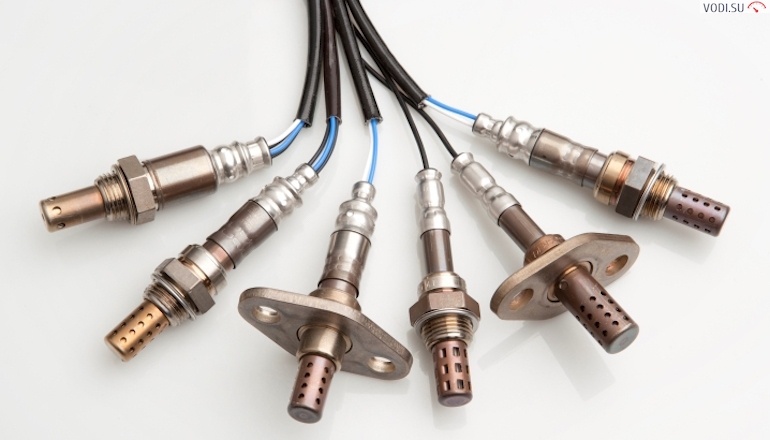
what is it, where is it located and what is it for?
A modern car is a technically complex device. Particularly striking is the large number of different sensors for measuring all engine operation parameters without exception.
Information from these sensors is sent to the electronic control unit, which is processed according to complex algorithms. Based on the received data, the ECU selects the optimal mode of operation by transmitting electrical impulses to the actuators.
One of these sensors is a lambda probe, which we have already mentioned several times on the pages of our Vodi.su autoportal. What is it for? What functions does it perform? We will try to consider these questions in this article.

Purpose
Another name for this measuring device is an oxygen sensor.
In most models, it is installed in the exhaust manifold, into which exhaust gases from the car's engine enter under high pressure and at high temperatures.
Suffice it to say that the lambda probe can correctly perform its functions when it warms up to 400 degrees.
The lambda probe analyzes the amount of O2 in the exhaust gases.
Some models have two of these sensors:
- one in the exhaust manifold before the catalytic converter;
- the second one immediately after the catalyst for a more accurate determination of the parameters of fuel combustion.
It is not difficult to guess that with the most efficient operation of the engine, as well as the injection system, the amount of O2 in the exhaust should be minimal.
If the sensor determines that the amount of oxygen exceeds the norm, a signal is sent from it to the electronic control unit, respectively, the ECU selects an operating mode in which the supply of air-oxygen mixture to the vehicle's engine is reduced.
The sensitivity of the sensor is quite high. The optimal mode of operation of the power unit is considered if the air-fuel mixture entering the cylinders has the following composition: 14,7 part of fuel falls on 1 parts of air. With the coordinated work of all systems, the amount of residual oxygen in the exhaust gases should be minimal.
In principle, if you look, the lambda probe does not play a practical role. Its installation is justified only by strict eco-standards for the amount of CO2 in the exhaust. For exceeding these standards in Europe, serious fines are provided.
Device and principle of operation
The device is quite complicated (for those people who are poorly versed in chemistry). We will not describe it in detail, we will give only general information.
Principle of operation:
- 2 electrodes, external and internal. The outer electrode has a platinum coating, which is very sensitive to the oxygen content. The internal sensor is made of zirconium alloy;
- the inner electrode is under the influence of exhaust gases, the outer one is in contact with atmospheric air;
- when the internal sensor is heated in the zirconium dioxide ceramic base, a potential difference is formed and a small electrical voltage appears;
- this potential difference and determine the oxygen content in the exhaust gases.
In a perfectly burnt mixture, the Lambda index or the excess air coefficient (L) is equal to one. If L is greater than one, then too much oxygen and too little gasoline enters the mixture. If L is less than one, then oxygen does not burn out completely due to excess gasoline.
One of the elements of the probe is a special heating element to heat the electrodes to the required temperatures.
Malfunctions
If the sensor fails or transmits incorrect data, then the electronic “brains” of the car will not be able to supply correct impulses to the injection system about the optimal composition of the air-fuel mixture. That is, your fuel consumption may increase, or vice versa, traction will decrease due to the supply of a lean mixture.
This, in turn, will lead to a deterioration in engine performance, a drop in power, a decrease in speed and dynamic performance. It will also be possible to hear a characteristic crackle in the catalytic converter.
Causes of failure of the lambda probe:
- low-quality gasoline with a high content of impurities - this is a common reason for Russia, since the fuel contains a lot of lead;
- engine oil getting on the sensor due to wear of the piston rings or their poor installation;
- wire breaks, short circuits;
- foreign technical fluids in the exhaust;
- mechanical damage.
It is also worth mentioning that many drivers in Russia replace the catalyst with a flame arrester. We already wrote on Vodi.su why they do it. After this operation, the need for a second lambda probe disappears (which was in the resonator behind the catalytic converter), since the flame arrester is not able to clean the exhaust gases as efficiently as the catalyst.
In some models, it is quite possible to abandon the lambda probe by reprogramming the electronic control unit. In others, this is not possible.
If you want the fuel to be consumed as economically as possible, and the engine to work optimally, then it is better to leave the lambda probe all the same.
Loading…
